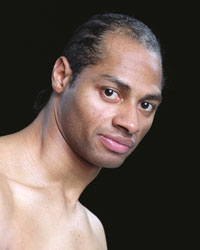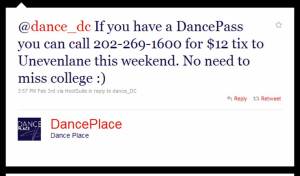American University’s Arts Management Program, Emerging Leaders Network and the Emerging Arts Leaders DC sponsored the 4th Annual Emerging Arts Leaders Symposium yesterday at American University’s Katzen Arts Center. Young professionals who work in the arts came from Boston, Chicago and all the way from Dupont Circle (that’s me!) to discuss issues affecting arts organizations. The event concluded with a keynote address from Rachel Goslins, Executive Director of the President’s Committee on the Arts and Humanities. Below is a break down of the panel discussions:
Panel 1: Getting the experience … and the job

The 4th Annual EALS took place at the Katzen Arts Center at AU yesterday.
I have been pursuing a career in the arts for some time now. I’m happy to say that I have finally made that transition! Next week, I’ll be joining Joy of Motion Dance Center as their Marketing and PR Manager. Using social media tools and consistently writing about the topic of dance in DC helped me make the right connections in order to land a job. I also volunteered a lot. These tactics were brought up during the first panel session of the day which included Ann Norris of Gallim Dance, Abel Lopez of GALA Hispanic Theatre, Katy Cupples of the DeVos Institute of Arts Management and the Kennedy Center and Anne L’Ecuyer of Washington Writer’s Retreat.
According to L’Ecuyer, there are three important criteria to consider before applying to arts jobs:
- What level of organization do you want to be at – local, state, national?
- What size organization do you want to be a part of?
- How close to the creative process do you want to be?
Determining the answers to these questions can help narrow your job search and ensure that you are the right fit for the organizations you are applying to. Organizations are vehicles to establish our own personal missions, not the other way around, she added.
Panel 2: Global Connections in Arts Management

Sarah Frankland previously worked at the British Council in DC. This is a picture of the one in Dubai, but look how cool it is!
Pennie Ojeda of NEA, Anna Smith of International Arts and Artists, Sarah Frankland formerly of the British Council and Brett Egan of the DeVos Institute of Arts Management at the Kennedy Center discussed issues relevant to the globalized arts community in this panel session. Each panelist had an interesting story to tell about how their life journeys led them to the positions they hold today. Ojeda was a Peace Corps volunteer and later full-time employee. Smith worked abroad in Amsterdam and Paris. Frankland moved from her native UK and fell in love with the United States. Egan worked with artists in China during the Summer Olympics in Beijing.
According to Egan, the state of the economy is going to make us think more about the impact and outcomes of international engagement. Organizations that value cultural exchange will need more than their mission statement to justify their activities. In order to make your case, Frankland suggests building an evaluation component before the process starts. Establish objectives and determine how you’re going to measure success. First and foremost, however, you need to know your audience, said Ojeda. The more people doing international exchanges – the better, but it has to make sense for the community.
Panel 3: What Makes a Good Arts Leader?
This was by far my favorite panel of the day. Moderator Michael Wilkerson, Assistant Professor of Arts Management at AU, brought the jokes and effectively managed the discussion among Ian David Moss of Fractured Atlas and Createquity.com, Jamie Bennett of NEA, Stephanie Evans Hanson of Americans for the Arts and Michael Bobbitt of Adventure Theatre and the League of Washington Theatres. According to Wilkerson, there are two types of leaders – those who build upon what has come before them and year zero leaders who believe the history of the organization starts the day that they do. Beware of year zero leaders, he cautioned. He also made an interesting point about the hiring process. First rate leaders hire first rate people. They want employees who are smarter and more efficient than they are. Second rate leaders hire third rate people. Why hire someone who knows more than you do? Below are additional thoughts on leadership from the panelists:
- Stephanie Evans Hanson – It is crucial to be flexible in your career. It is also important to understand how decisions are made and how you can impact those decisions in your organization. It’s better to ask forgiveness than permission.
- Ian David Moss – In the arts, there is a tendency for people to wait until they are told to do something important. Not waiting has served me well. In meetings or conference calls, say what needs to be said. Leading the conversation is an exertion of power. Self education and understanding yourself are also a key way to demonstrate leadership.
- Michael Bobbitt – Get away from your desk! It’s hard for people to say no to you when you meet with them in person. People do business with people they know so get out there and engage with your community. Art has to marry the commerce. To be successful, make it more than just about the play, exhibit, dance performance. For example, Adventure Theatre worked with Project Linus’ Blanket – an organization that donates blankets to children in need as part of You’re A Good Man Charlie Brown.
- Jamie Bennett – Leadership isn’t about where you are in the organizational chart. Every leader is leading from the middle and anyone can make change from anywhere. To be a leader, you need to have vision and you need to understand the mechanics of change. It’s not enough to have an idea, but you also need to be able to translate your vision into action. Learn the language of the organization in order to make the sale.
Keynote Address: Rachel Goslins
 In addition to cleverly working Kevin Spacey movie titles such as The Usual Suspects, American Beauty and Pay It Forward into her speech, Rachel Goslins provided valuable advice to emerging arts leaders.
In addition to cleverly working Kevin Spacey movie titles such as The Usual Suspects, American Beauty and Pay It Forward into her speech, Rachel Goslins provided valuable advice to emerging arts leaders.
There are three types of people: arts lovers, arts antagonists and arts agnostics. Engage the lovers, don’t worry about the antagonists and focus instead on the agnostics. This audience is crucial to the future of the arts.
Don’t lose sight of your mission. When it comes to metrics, know what you’re measuring and why. Use these numbers to demonstrate that you are achieving your mission.
Arts education is critical to the future of schools and the future of non-profit arts. Students with access to arts education have been proven to do better academically and are also more likely to attend art related events.
Follow your passion. Take risks and remember it’s a gift to work in an industry that you truly care about.
 The DC Dance Marathon is a party with a purpose. The 13.1 hour dance event raises money for Metro Area Children’s Miracle Network Hospitals. While the event has been workin’ it on college campuses for years, it’s only in its second year in DC, but after raising $37K in 2011, it is back with boogie fever! Taking place on Saturday, November 17th at the FHI 360 Conference Center, the DC Dance Marathon is open to anyone with a passion for dance, no skill required! The event will feature a variety of dance styles, performances, games and activities, as well as stories from the lives impacted by this charitable dance marathon.
The DC Dance Marathon is a party with a purpose. The 13.1 hour dance event raises money for Metro Area Children’s Miracle Network Hospitals. While the event has been workin’ it on college campuses for years, it’s only in its second year in DC, but after raising $37K in 2011, it is back with boogie fever! Taking place on Saturday, November 17th at the FHI 360 Conference Center, the DC Dance Marathon is open to anyone with a passion for dance, no skill required! The event will feature a variety of dance styles, performances, games and activities, as well as stories from the lives impacted by this charitable dance marathon.






